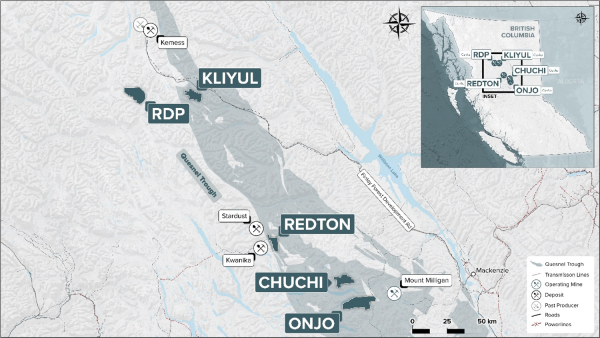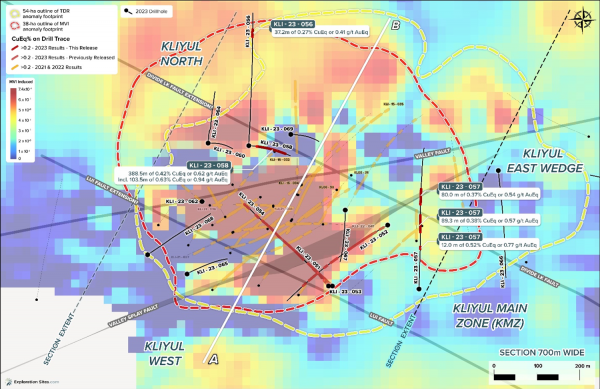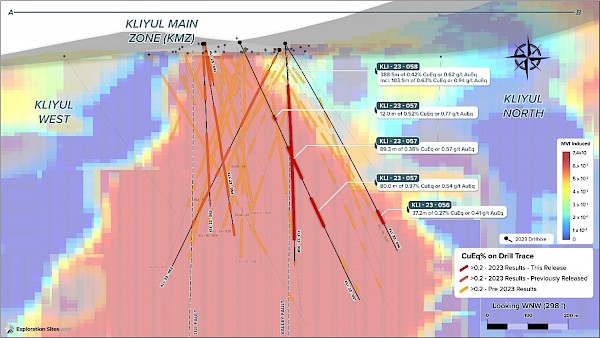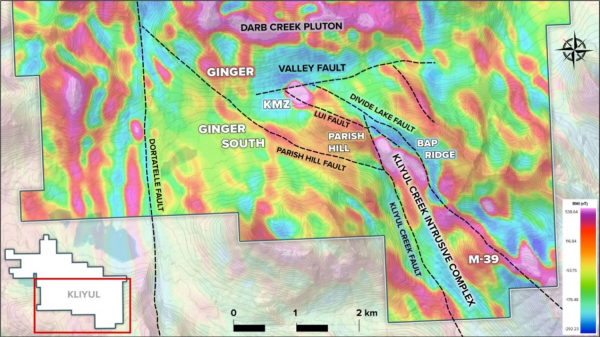Vancouver, B.C. – October 10, 2023 - Pacific Ridge Exploration Ltd. (PEX: TSX Venture; PEXZF: OTCQB) ("Pacific Ridge" or the "Company”) is pleased to announce additional drill results, for holes KLI-23-055 to KLI-23-058, from this year’s diamond drilling campaign at the Kliyul copper-gold porphyry project (“Kliyul” or “Project”) with drill hole KLI-23-058 intersecting 103.5 m of 0.63% copper equivalent (“CuEq”) (0.18% copper, 0.66 g/t gold, and 0.93 g/t silver) within 388.5 m of 0.42% CuEq (0.18% copper, 0.35 g/t gold and 1.05 g/t silver). Kliyul is located in the prolific Quesnel Terrane in northcentral British Columbia close to existing infrastructure (see Figure 1).
Pacific Ridge completed a total of 19 diamond drill holes (KLI-23-051 to KLI-23-069) totaling 10,284 metres at Kliyul this year, the largest ever exploration program at Kliyul. The Company announced drill results for holes KLI-23-051 to KLI-23-054 in August with drill hole KLI-23-054 intersecting 305.5 m of 0.59% CuEq (0.23% copper, 0.51 g/t gold, and 1.22 g/t silver) (see news release dated August 23, 2023). Results from the remaining 11 drill holes will be released once they are received and compiled.
Highlights
- KLI-23-058 returned 103.5 m of 0.63% CuEq (0.18% copper, 0.66 g/t gold, and 0.93 g/t silver) within 388.5 m of 0.42% CuEq (0.18% copper, 0.35 g/t gold and 1.05 g/t silver) from the Kliyul North zone (see Table 1). This interval represents a 130 m northern step-out from copper-gold mineralization in KLI-21-036 which returned 291.7 m of 0.79% CuEq (0.28% copper, 0.74 g/t gold and 2.04 g/t silver within 437 m of 0.64% CuEq (0.22% copper, 0.60 g/t gold and 1.62 g/t Ag) (see news release dated December 1, 2021).
- KLI-23-058 returned the best result from the Kliyul North zone to date and further proves that Kliyul Main Zone (“KMZ”) mineralization extends into adjacent fault blocks (see Figure 2 and 3). KLI-23-058 is one of three steep drill holes (also KLI-23-060 and KLI-23-069) spaced 100 m apart that were drilled as an east-west fence across the Kliyul North zone. Results of the other two drill holes are pending.
- Known extents of the Kliyul porphyry copper-gold complex now measure 600 m east-west, up to 600 m north-south (previously 450 m north-south), and up to 600 m vertical depth.
- KLI-23-057, drilled on the eastern side of the KMZ, returned 89.3 m of 0.38% CuEq (0.21% copper, 0.25 g/t gold and 0.91 g/t silver) from 290 m and 80.0 m of 0.37% CuEq (0.10% copper, 0.39 g/t gold and 0.85 g/t silver) from 433 m, extending KMZ mineralization 200 m east of KLI-22-045 and 135 m west of KLI-22-049, increasing confidence in the continuity of mineralization over a 600 m east-west distance from the western extent of KMZ to KLI-22-049 in East Wedge.
- KLI-23-056, drilled in Kliyul North as a 100 m step out to the west and north of KLI-22-046, returned 37.2 m of 0.27% CuEq (0.14% copper, 0.19 g/t gold and 1.07 g/t silver) from 513 m. While this is a narrow, low-grade interval, it is the second mineralized interval to intersect the western margin of a 400 x 200 m magnetic vector inversion anomaly (“MVI”) and Tilt Derivative (“TDR”) in an underexplored part of the Kliyul porphyry copper-gold complex, called Kliyul NE. From this same anomaly, KLI-22-046 returned 59.0 m of 0.84% CuEq (0.24% copper, 0.87 g/t gold, and 2.29 g/t silver) within 169 m of 0.52% CuEq (0.20% copper, 0.46 g/t gold, and 1.65 g/t silver) (see news release dated January 18, 2023) . The main body of the anomaly remains open and undrilled 400 m northeast of the center of KMZ.
- KLI-23-055, was the first drill hole to test the Ginger target (see Figure 4), an interpreted standalone porphyry target area 1.3 km northwest of the center of KMZ and at an elevation 200 m above KMZ. Drilling intersected a broad zone of chlorite-sericite and sericitic alteration with late-stage veins. Massive white quartz veins, interpreted as D-veins or late Lode veins, have low-grade gold returning 19.1 m of 0.36 g/t gold equivalent (“AuEq”) (0.01% copper, 0.34 g/t gold and 0.65 g/t silver). The veins are also anomalous in copper, molybdenum (up to 0.12% over 1.25 m), tungsten, tellurium, and bismuth.
- A combination of IP chargeability high (>20 mV/V), DC resistivity high (>2000 ohm-m) and moderate-to-high MVI Induced 3D model values continues to be a reliable geophysical targeting signature for mineralization at Kliyul. In addition, a TDR standard filtering of the 2022 aeromagnetic data is now being used to enhance and refine the Kliyul porphyry copper-gold complex footprint.
“This second set of results from this year’s drill program at Kliyul are significant for a number of reasons,” said Blaine Monaghan, President & CEO of Pacific Ridge. “Hole 58 was the best ever drill result from Kliyul North and proves that KMZ mineralization extends into adjacent fault blocks. In addition, the results increased the known extents of the Kliyul porphyry copper-gold complex another 150 m north-south. It now measures 600 m east-west, up to 600 m north-south, and up to 600 m vertical depth. I’m confident that the known extents will be even larger after we have announced all of this year’s drill results.”
Figure 1
Location of Kliyul
Figure 2
Plan View of the Kliyul Porphyry Copper-Gold Complex (Kliyul West, KMZ, East Wedge, and Kliyul North) with MVI
Figure 3
Cross Section – Looking West-Northwest
Figure 4
Kliyul Targets and Relative Magnetic Intensity (RMI) from 2022 Airborne Magnetics Survey
Table 1
2023 Kliyul Assay Results Summary for Drill Holes KLI-23-055 to KLI-23-058
Click on the link below for previous Pacific Ridge drill results at Kliyul.
https://pacificridgeexploration.com/site/assets/files/5956/2023-10-01_kliyul_assays_36-54.pdf
Discussion of Drill Holes KLI-23-055 to KLI-23-058
The second four drill holes of the 2023 Kliyul diamond drilling program tested for northern and eastern extensions of KMZ style mineralization within the Kliyul porphyry copper-gold complex, and for an additional porphyry deposit center 1.3 km northwest of KMZ within the 6-km-long Divide Lake Fault Trend. Results indicate that KMZ mineralization continues for at least 60 m into Kliyul North beyond the Valley Fault. As well, drilling increased confidence that continuity of KMZ mineralization spans over a 600 m east-west distance from the western extent of KMZ to KLI-22-049 in East Wedge. Drilling at the Ginger target area, 1.3 km northwest of KMZ did not intersect early-stage porphyry mineralization, veins, or alteration, but did intersect late-stage gold-bearing massive quartz veins attesting to the fertility and size of the Kliyul porphyry copper-gold complex area and surroundings.
- KLI-23-058 returned the best result from the Kliyul North zone to date, and further proves that KMZ mineralization extends into adjacent fault blocks. KLI-23-058 is one of three steep drill holes (also KLI-23-060 and KLI-23-069) spaced 100 m apart that were drilled as an east-west fence across Kliyul North. Given the bell-shaped geometry of the 3D MVI magnetic anomaly (see Figure 3) and inferred porphyry Cu-Au mineralization shell with associated quartz diorite dyke complex, it was found that steeply inclined drilling along fences provides the best control for understanding the distribution of KMZ mineralization, and vectoring towards better grade.
- KLI-23-057 was drilled in eastern KMZ from south to north at a moderate inclination and encountered continuous mineralization after 290 m drilling depth (240 m vertical depth). Similar to East Wedge, mineralization is associated with low (<20 mV/V) as well as high chargeability, perhaps due to proximity with Divide Lake Fault zone. This means that mineralization remains open to the south where there is a deepening low-to-high chargeability gradient, high resistivity, and magnetic high signature within the TDR and 3D MVI anomaly (see Figure 2). Also, of interest is a zone of high Au:Cu ratio (average 58.7 with maximum of 398.8 over 1.47 m) from 433.0-485.0 m, that is centered on the Divide Lake Fault zone at 440.5-464.0 m. This 52.4 m interval includes the above listed interval of 34.0 m at 0.66% AuEq (0.03% copper, 0.604 g/t gold and 1.32 g/t silver).
- KLI-23-056 was drilled from south to north at moderate inclination, and near the northwestern margin of a TDR magnetic high footprint in Kliyul North, returning a narrow, low-grade mineralized interval at depth. However, it strongly suggests, along with the result from KLI-22-046, that a large (400 x 200 m) combined TDR and 3D MVI magnetic high anomaly located 400 m northeast of the center of KMZ (see Figure 2) could be mineralized, and that drilling to date has only skimmed its western margin. This target area, called Kliyul NE, will be a 2024 focus. Induced Polarization (IP) geophysical indicators also compellingly show a KMZ mineralization signature in the area.
- KLI-23-055 in Ginger further support the interpretation that there is good preservation potential for at least one or more near-surface porphyry Cu-Au deposits in the valley bottoms at Kliyul and that the surrounding gossanous slopes at higher elevation, such as at Ginger cirque or BAP Ridge represent the broad overlying sericitic (quartz-sericite-pyrite) alteration shell and related veins.
Summary of Drill Holes KLI-23-055 to KLI-23-058
KLI-23-055 (azimuth 222°, inclination -75°, planned length 600 m, drilled length 413 m) was the first drill hole to test the Ginger target area for a standalone porphyry Cu-Au deposit, 1.3 km northwest of KMZ within the Divide Lake Fault Trend. Results from 2022 exploration suggested there may be a northeast-tilted porphyry system with a core zone starting at about 300 m depth. There is only one historical drill hole in the area, 450 m to the southwest, that was shallow drilled (to 100 m vertical depth) and intersected post-mineral granodiorite. The drill hole was collared on the west side of Ginger cirque at 1,955 m a.s.l., almost 200 m higher elevation than KMZ.
- Lithology consists of basaltic-andesitic volcaniclastic rocks intruded by narrow diorite and feldspar hornblende porphyry dykes up to 15 m in width.
- Alteration is predominantly chlorite-sericite and sericitic overprinting patchy magnetite ± chlorite-biotite-actinolite. Propylitic alteration increases after 323.5 m. Veins are mainly late-stage pyritic D-veins with chlorite-sericite alteration halos and late-stage calcite and anhydrite veins. Local irregular magnetite veins are noted associated with diorite.
- Mineralization consists of pyrite as disseminations and fracture fill. Two massive milky white quartz ± chlorite-sericite-pyrite veins, 0.9 m and 6.1 m width are logged at 197.9 m and 300.8 m returning 19.1 m of 0.34 g/t gold (“Au”) and 0.65 g/t silver (“Ag”), and 3.7 m of 0.22 g/t Au and 0.93 g/t Ag respectively. These interpreted D-veins or late Lode veins are also anomalous in copper (“Cu”), molybdenum (up to 0.12% over 1.25 m), tungsten, tellurium, and bismuth. A molybdenite sample was collected for rhenium-osmium dating.
KLI-23-056 (azimuth 357°, inclination -55°, planned length 450 m, drilled length 600 m) was drilled in the Kliyul North zone as a 170 m step-out to the northwest of KLI-22-046, which extended mineralization 250 m north of KMZ and returned 59.0 m 0.84% CuEq (0.24% Cu, 0.87 g/t Au, and 2.29 g/t Ag) within 169 m of 0.52% CuEq (0.20% Cu, 0.46 g/t Au, and 1.65 g/t Ag) (see news release dated January 18, 2023). KLI-23-056 tested for an extension of the KLI-22-046 result, as well as for a moderately south-dipping attitude of mineralization and associated intrusions.
- Lithology is mainly volcaniclastic andesite with diorite dykes which increase in abundance after 340 m becoming more than 50% of the lithology.
- Alteration is strongly sericitic with subordinate chlorite-sericite to 126 m and then becomes alternating inner-propylitic (epidote-albite-chlorite-sericite-quartz) and intermediate argillic (sericite-illite-chlorite) spatially related to a fault zone (Divide Lake Fault extension?) at 225-233 m. Local patchy magnetite ± chlorite/biotite (potassic) alteration is noted. Veins are predominantly late-stage calcite and secondarily intermediate-stage epidote-albite and quartz-sericite-albite.
- Mineralization is vein-hosted, fracture fill and disseminated pyrite. After 364 m, trace to weak fine-disseminated chalcopyrite is noted locally.
- The 37.2 m interval of 0.27% CuEq (0.14% Cu, 0.19 g/t Au and 1.07 g/t Ag) from 513 m is associated with an increase in magnetite-chlorite/biotite alteration, fine disseminated chalcopyrite and possible lithology change to diorite.
KLI-23-057 (azimuth 357°, inclination -55°, planned length 600 m, drilled length 611 m) was designed to test the under-drilled eastern side of KMZ and drill northward towards Divide Lake Fault and then into the East Wedge zone at depth. The nearest drill holes include KLI-15-033, collared 130 m to the north, which returned 69.5 m of 0.28% Cu, 0.39 g/t Au, and 1.57 g/t Ag starting at 32.5 m (see news release dated January 17, 2020); and KLI-22-049, collared 155 m to the northeast, which returned 66.0 m of 0.23% Cu, 0.24 g/t Au, and 0.90 g/t Ag starting at 250.0 m in the East Wedge zone(see news release dated January 18, 2023).
- Lithology is mainly volcaniclastic andesite host rock (about 64%) intruded by various early to late-stage dykes including, 1) quartz diorite, 2) feldspar porphyry, 3) andesite dykes and 4) feldspar hornblende porphyry. The high density of dykes appears to be spatially related to the Divide Lake Fault corridor. A zone of anhydrite-quartz-calcite cemented breccia intercalated with diorite occurs between 662-700 m. An intrusive breccia at 707.5 m has megacrystic porphyry fragments (early) in feldspar porphyry cement (later).
- Alteration is a mix of chlorite-sericite and inner-propylitic (epidote-calcite ± albite). Potassic (magnetite-chlorite/biotite) alteration begins at 192 m and alternates with inner-propylitic alteration becoming more bleached by silicification (quartz-anhydrite ± sericite) after 655 and continuing to end-of-hole (EOH). This alteration zoning suggests vectoring up-temperature with depth. Veins include early, intermediate, and late-stage types, but early-stage veins are more predominant between 202.5-528.8 m and continue to EOH.
- Mineralization is disseminated and vein-hosted pyrite. Trace chalcopyrite starts at 58.4 m in intermediate-stage veins, and after 202.5 m with early-stage veins and stringers, including fine-grained clustered disseminations, and after 484.7 m with anhydrite-quartz stockwork/breccia. Metre-scale massive white quartz veins with accessory chlorite and pyrite-chalcopyrite-molybdenite mineralization occur at 88.4 m, 257.9 m and 460.1 m; these appear to be late-stage veins related to brittle faulting.
- The 89.3 m interval of 0.38% CuEq (0.21% Cu, 0.25 g/t Au and 0.91 g/t Ag) from 290 m is related to magnetite-chlorite/biotite alteration and early-stage veins. The 86.0 m interval of 0.36% CuEq (0.10% Cu, 0.39 g/t Au and 0.85 g/t Ag) from 433 m is proximal to the Divide Lake Fault/Valley Splay Fault intersection and related to quartz-sericite-ankerite-chlorite ± epidote alteration overprinting relict magnetite with a mix of early-and late-stage veins.
KLI-23-058 (azimuth 090°, inclination -80°, planned length 550 m, drilled length 560 m) was collared from the same drill pad as KLI-23-056. This steeply inclined drill hole tested the Kliyul North zone at depth in a gap area where there is the same geophysical signature as KMZ. The nearest deep drill hole, KLI-22-044, is 100 m to the southeast and returned 23.2 m of 0.89% CuEq (0.24% Cu, 0.94 g/t Au, and 1.40 g/t Au) starting at 409.0 m within the Kliyul North zone (see news release dated November 16, 2022).
- Lithology is mainly volcaniclastic andesite host rock (about 74%) intruded by various early to late-stage dykes, ranging from 1.5 m to 34.9 m wide including, 1) quartz diorite, 2) quartz feldspar porphyry, 3) andesite dykes and 4) hornblende porphyry. A megacrystic feldspar porphyry (QFP) unit was intersected from 478.6-530 m (51.4 m wide). A fault and rubble zone were encountered from 154-192.7 m suggesting a flat-lying or shallowly dipping fault.
- Alteration is sericitic and inner-propylitic to 126 m, after which magnetite-chlorite/biotite (potassic) alteration starts. Following this, the potassic assemblage is locally overprinted by inner-propylitic and chlorite-sericite, the latter becoming a more prevalent overprint after 436 m. Ignoring late-stage veins, intermediate-stage veins predominate from 74-385 m and then early-stage veins from 385 m to EOH.
- Mineralization includes disseminated, fracture fill and vein-hosted pyrite. Chalcopyrite in trace amounts starts near surface and becomes more abundant by 74 m, occurring as fine-grained disseminations, fracture fill and in intermediate- and early-stage veins.
- The 103.5 m interval of 0.63% CuEq (0.18% Cu, 0.66 g/t Au and 0.93 g/t Ag) within 388.5 m of 0.42% CuEq (0.18% Cu, 0.35 g/t Au and 1.05 g/t Ag) is related to magnetite-chlorite/biotite alteration with chlorite-sericite overprint and early-stage veins in the hanging wall zone of the megacrystic feldspar porphyry dyke. Also of note, the Au:Cu ratio of weighted average mineralized intervals increases with depth from 87 m to 493.5 m where the megacrystic porphyry dyke is logged, suggesting an up-temperature vector of increasing Au:Cu (from 0.71 to 5.27), and an inverse relationship for Ag:Au (from 9.64 to 1.08; see Table 2).
Table 2
2023 Kliyul Assay Results Summary for Drill Hole KLI-23-058 With Au:Cu and Ag:Au Ratios at Increasing Depth.
About Kliyul
Owned 100% by Pacific Ridge, Kliyul is over 60 km2 in size and is located in the prolific Quesnel Terrane close to existing infrastructure. Kliyul comprises nine porphyry copper-gold targets along two main trends: the 1.5 km-long east-northeast Valley Fault Trend, which includes its five fault-defined target areas (Kliyul West, KMZ, Kliyul North, East Wedge, and Kliyul East); and the 6-km-long northwest-trending Divide Lake Fault Trend which includes Ginger, Parish Hill, Bap Ridge, and M-39 target areas.
QA/QC (Quality Assurance/Quality Control)
Pacific Ridge’s 2023 exploration program is being managed by Equity Exploration Consultants Ltd. of Vancouver, B.C. The drill contractor is Paycore Drilling of Valemount, B.C. Half-core HQ (63.5 mm) or NQ (47.6 mm) sawed samples from continuous intervals throughout the reported drill holes were sealed on site and shipped to ALS Global Laboratories (“ALS”) preparation lab in Kamloops or North Vancouver, BC. Fire assay and multielement analyses were completed at ALS Minerals analytical laboratory in North Vancouver. Drill core was crushed, pulverized and analyzed for 48 elements using a four-acid dissolution followed by ICP-MS (ME-MS61) with over limits by ore grade four-acid dissolution followed by ICP-AES (OG62), with a 30 g sample analyzed for gold by fire assay and atomic absorption finish (Au-AA23). Blanks and commercially certified reference materials were inserted blind into the sample stream with an overall insertion rate of 5%. Field duplicates representing a quarter core split of the original sample are inserted at 2.5%. Pulp and crush duplicates are inserted at 5% insertion rate by the laboratory. The QAQC results are reviewed as batches are returned from the laboratory and appropriate actions are implemented where required. The QA/QC results for the reported drill holes are acceptable.
About Pacific Ridge
Our goal is to become British Columbia’s leading copper-gold exploration company. Pacific Ridge’s flagship asset is its 100% owned Kliyul copper-gold project, located in the Quesnel Terrane close to existing infrastructure. In addition to Kliyul, the Company’s project portfolio includes the RDP copper-gold project (optioned to Antofagasta Minerals S.A.), the Chuchi copper-gold project, the Onjo copper-gold project, and the Redton copper-gold project, all located in British Columbia. Pacific Ridge would like to acknowledge that its B.C. projects are located in the traditional, ancestral and unceded territories of the Gitxsan Nation, McLeod Lake Indian Band, Nak’azdli Whut’en, Takla Nation, and Tsay Keh Dene Nation.
On behalf of the Board of Directors,
“Blaine Monaghan”
Blaine Monaghan
President & CEO
Pacific Ridge Exploration Ltd.
Corporate Contact:
Blaine Monaghan
President & CEO
Tel: (604) 687-4951
www.pacificridgeexploration.com
https://www.linkedin.com/company/pacific-ridge-exploration-ltd-pex-
https://twitter.com/PacRidge_PEX
Investor Contact:
G2 Consultants Corp.
Telephone: +1 778-678-9050
Email: ir@pacificridgeexploration.com





